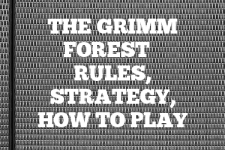A Guide to New York 1901 – Rules, Strategy & How to Play Instructions
Introduction
New York 1901 is a board game that takes you back to the early days of skyscrapers and big city dreams. In this game, you play as a developer in New York City during the year 1901, competing to build the most impressive skyscrapers on the famous streets like Wall Street and Broadway. The game combines strategy with a bit of luck, as players choose plots of land, demolish old buildings, and construct new ones to earn points and win the game.

The game was created by Chénier La Salle and released in 2015. It quickly gained popularity among board game enthusiasts for its easy-to-learn rules and strategic depth. The game’s artwork and components are inspired by the Art Nouveau style of the early 20th century, which adds to the thematic experience and gives a nice aesthetic in my opinin. New York 1901 is a game that can be enjoyed by families and serious gamers alike, given the gameplay has a mix of tactical decision-making and historical flavor. I find it has a lot of the hallmarks of a classic family game.
Quick Tip for New York 1901
Always keep an eye on your opponents’ territories and be ready to grab key plots of land before they do!
Rules for playing New York 1901
Understanding the rules of New York 1901 is essential to play the game effectively. The game is played on a board depicting the streets of Lower Manhattan. Players start with a small amount of land and work their way up to building the iconic skyscrapers of New York.
The game is played over a series of turns, with each player performing two actions on their turn: acquiring new land or building on existing land. Players can also demolish their older buildings to make way for newer, taller skyscrapers. The game ends when a player has built all of their skyscrapers or when the land cards run out. Points are then tallied based on the size and height of the buildings, as well as bonus points for fulfilling specific objectives.
Throughout the game, players must manage their workers, as they are needed to acquire land and construct buildings. There are also special action cards that can give players an advantage, such as allowing them to perform extra actions or build without workers.
It’s important to balance your strategy between expanding your territory, building valuable skyscrapers, and preventing your opponents from doing the same. The player with the most points at the end of the game is declared the winner and the most successful developer in New York 1901.
Equipment and Setup for New York 1901
To play New York 1901, you’ll need the game board, land cards, building tiles, workers, action cards, and the King token. The building tiles come in three types: bronze, silver, and gold, representing different eras of skyscrapers.
Setting up the game involves placing the board in the center of the table and shuffling the land cards. Each player chooses a color and takes the corresponding skyscrapers, workers, and the starting building. Players also receive two random land cards to begin with.
If you don’t have the game, you can create a DIY version using a grid to represent the streets of Manhattan and paper cutouts for the buildings and land cards. However, having the actual game components enhances the experience with its thematic artwork and sturdy tiles.
How to Play New York 1901 and Game Mechanics
Playing New York 1901 involves a few key game mechanics:
- Setup: After setting up the board and distributing the initial components, determine the starting player and give them the King token.
- Gameplay: On your turn, you can either acquire a new land lot by placing a worker on an available land card or build a skyscraper on a lot you own. You can also demolish an existing building to construct a new one.
- End of the Game: The game ends when a player has placed all their skyscrapers or the land cards are depleted. Points are then scored based on buildings and bonuses.
During the game, players go through the following phases:
- Acquisition Phase: Choose a land card and place a worker on it to claim the lot.
- Construction Phase: Build a skyscraper on a lot you own, following the building rules.
- Demolition Phase (optional): Demolish an existing building to construct a new one.
- Special Actions (optional): Use an action card to perform special actions.
How to Win at New York 1901
To win at New York 1901, you need to have a solid strategy. Beginners should focus on understanding the value of different buildings and lots. Intermediate players can start to anticipate opponents’ moves and block them when possible. Advanced players will need to optimize their use of workers and action cards, as well as aim for bonus points through objective cards.
It’s also crucial to adapt your strategy based on the game’s progress and your opponents’ actions. Sometimes, it’s better to go for smaller buildings that can be built quickly rather than waiting to gather resources for a larger skyscraper. Pay attention to the bonus challenges as they can provide a significant point boost.
Best Strategies for playing New York 1901 game
Here are some of the best strategies for playing New York 1901:
- Focus on acquiring lots that are adjacent to each other to give you more flexibility in building.
- Keep an eye on the available action cards and plan your turns to make the best use of them.
- Be aware of the timing. Knowing when to demolish and rebuild can give you an edge over your opponents.
- Don’t ignore the bonus challenges. They can be a tiebreaker in close games.
Remember, while having a plan is important, being able to adapt to the changing game state is what separates good players from great ones.
Scenarios
Here are some common scenarios you might encounter:
- If you’re blocked from acquiring a key lot, consider focusing on another area of the board or using an action card to disrupt your opponent’s plans.
- If you’re running low on workers, prioritize actions that will free them up or consider using an action card that allows you to build without workers.
In both cases, staying flexible and having a backup plan can help you turn a bad situation to your advantage.
Frequently Asked Questions about playing New York 1901 game
Q: Can I build more than one skyscraper per turn?
A: No, you can only build or demolish one skyscraper per turn.
Q: What happens if I run out of workers?
A: You cannot acquire new land lots until you free up a worker by building on a lot they occupy.
Q: Can I move my skyscrapers once built?
A: No, once a skyscraper is built, it cannot be moved unless it is demolished.
Q: How do I earn bonus points?
A: Bonus points are earned by fulfilling specific objectives on bonus challenge cards.
Q: Is there a limit to how many action cards I can have?
A: Yes, you can only have one action card at a time.
Additional Tips and Tricks
Here are some extra tips to help you in your quest to become the top developer in New York 1901:
- Plan your moves in advance, but be ready to change your strategy if the situation on the board changes.
- Watch other players’ moves closely. You can learn a lot about their strategies and possibly predict their next actions.
- Don’t underestimate the power of action cards. They can provide a significant advantage when used at the right time.
External Links
For more information about New York 1901, check out the following links:

A digital native around since the early days of online gaming communities around 2001. An early contributor to the cult gaming site ClanTemplates, Adam has spent years giving free gaming resources to the community. With BoardCards, Adam is most experienced and commonly writing the articles on Strategy multi-player games like Settlers of Catan and Avalon. His first introduction to board games was via Mancala, an Egyptian-origin stone game and one of the oldest known games still played worldwide. Contact me via email



